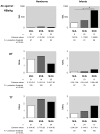Maternal infection with Trypanosoma cruzi and congenital Chagas disease induce a trend to a type 1 polarization of infant immune responses to vaccines
- PMID: 20041029
- PMCID: PMC2796860
- DOI: 10.1371/journal.pntd.0000571
Maternal infection with Trypanosoma cruzi and congenital Chagas disease induce a trend to a type 1 polarization of infant immune responses to vaccines
Abstract
Background: We previously showed that newborns congenitally infected with Trypanosoma cruzi (M+B+) display a strong type 1 parasite-specific T cell immune response, whereas uninfected newborns from T. cruzi-infected mothers (M+B-) are prone to produce higher levels of proinflammatory cytokines than control neonates (M-B-). The purpose of the present study was to determine if such fetal/neonatal immunological environments could alter the response to standard vaccines administered in early life.
Methodology: Infants (6-7 months old) living in Bolivia, an area highly endemic for T. cruzi infection, and having received Bacillus Calmette Guerin (BCG), hepatitis B virus (HBV), diphtheria and tetanus vaccines, were enrolled into the M+B+, M+B-, M-B- groups mentioned above. The production of IFN-gamma and IL-13, as markers of Th1 and Th2 responses respectively, by peripherical blood mononuclear cells stimulated with tuberculin purified protein derivative of Mycobacterium tuberculosis (PPD) or the vaccinal antigens HBs, diphtheria toxoid (DT) or tetanus toxoid (TT), as well as circulating levels of IgG antibodies against HBsAg, DT and TT were analyzed in infants. Cellular responses to the superantigen SEB were also monitored in M+B+, M+B-, M-B-infants and newborns.
Principal findings: M+B+ infants developed a stronger IFN-gamma response to hepatitis B, diphtheria and tetanus vaccines than did M+B- and M-B- groups. They also displayed an enhanced antibody production to HBsAg. This was associated with a type 1-biased immune environment at birth, since cells of M+B+ newborns produced higher IFN-gamma levels in response to SEB. M+B- infants produced more IFN-gamma in response to PPD than the other groups. IL-13 production remained low and similar in all the three groups, whatever the subject's ages or vaccine status.
Conclusion: These results show that: i) both maternal infection with T. cruzi and congenital Chagas disease do not interfere with responses to BCG, hepatitis B, diphtheria and tetanus vaccines in the neonatal period, and ii) the overcoming of immunological immaturity by T. cruzi infection in early life is not limited to the development of parasite-specific immune responses, but also tends to favour type 1 immune responses to vaccinal antigens.
Conflict of interest statement
The authors have declared that no competing interests exist.
Figures




Similar articles
-
Effect of antenatal parasitic infections on anti-vaccine IgG levels in children: a prospective birth cohort study in Kenya.PLoS Negl Trop Dis. 2015 Jan 15;9(1):e0003466. doi: 10.1371/journal.pntd.0003466. eCollection 2015 Jan. PLoS Negl Trop Dis. 2015. PMID: 25590337 Free PMC article.
-
[Immune responses of non-infected neonates of mothers infected with Trypanosoma cruzi].Rev Soc Bras Med Trop. 2005;38 Suppl 2:96-100. Rev Soc Bras Med Trop. 2005. PMID: 16482825 Spanish.
-
Is Antibody-Dependent Enhancement of Trypanosoma cruzi Infection Contributing to Congenital/Neonatal Chagas Disease?Front Immunol. 2021 Sep 10;12:723516. doi: 10.3389/fimmu.2021.723516. eCollection 2021. Front Immunol. 2021. PMID: 34566981 Free PMC article.
-
Infection and invasion mechanisms of Trypanosoma cruzi in the congenital transmission of Chagas' disease: a proposal.Biol Res. 2010;43(3):307-16. Epub 2010 Nov 30. Biol Res. 2010. PMID: 21249302 Review.
-
Epidemiology and pathogenesis of maternal-fetal transmission of Trypanosoma cruzi and a case for vaccine development against congenital Chagas disease.Biochim Biophys Acta Mol Basis Dis. 2020 Mar 1;1866(3):165591. doi: 10.1016/j.bbadis.2019.165591. Epub 2019 Oct 31. Biochim Biophys Acta Mol Basis Dis. 2020. PMID: 31678160 Free PMC article. Review.
Cited by
-
Chagasic patients are able to respond against a viral antigen from influenza virus.BMC Infect Dis. 2012 Aug 24;12:198. doi: 10.1186/1471-2334-12-198. BMC Infect Dis. 2012. PMID: 22920436 Free PMC article.
-
Maternal Helminth Infection Causes Dysfunctional B Cell Development in Male Offspring.J Immunol. 2024 Oct 15;213(8):1157-1169. doi: 10.4049/jimmunol.2400158. J Immunol. 2024. PMID: 39185897
-
Trypanosoma cruzi activates cord blood myeloid dendritic cells independently of cell infection.Med Microbiol Immunol. 2012 Aug;201(3):287-96. doi: 10.1007/s00430-012-0230-9. Epub 2012 Feb 12. Med Microbiol Immunol. 2012. PMID: 22327272
-
Factors That Influence the Immune Response to Vaccination.Clin Microbiol Rev. 2019 Mar 13;32(2):e00084-18. doi: 10.1128/CMR.00084-18. Print 2019 Mar 20. Clin Microbiol Rev. 2019. PMID: 30867162 Free PMC article. Review.
-
Effect of antenatal parasitic infections on anti-vaccine IgG levels in children: a prospective birth cohort study in Kenya.PLoS Negl Trop Dis. 2015 Jan 15;9(1):e0003466. doi: 10.1371/journal.pntd.0003466. eCollection 2015 Jan. PLoS Negl Trop Dis. 2015. PMID: 25590337 Free PMC article.
References
-
- WHO. 2005. The World Health Report.
-
- Seder RA, Hill AV. Vaccines against intracellular infections requiring cellular immunity. Nature. 2000;406:793–798. - PubMed
-
- Siegrist CA. The challenges of vaccine responses in early life: selected examples. J Comp Pathol. 2007;137(Suppl 1):S4–S9. - PubMed
-
- Hermann E, Truyens C, Alonso-Vega C, Even J, Rodriguez P, et al. Human fetuses are able to mount an adultlike CD8 T-cell response. Blood. 2002;100:2153–2158. - PubMed
Publication types
MeSH terms
Substances
LinkOut - more resources
Full Text Sources
Medical
Miscellaneous

